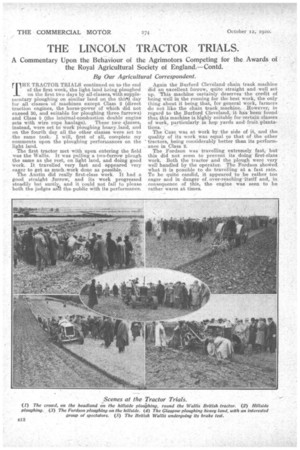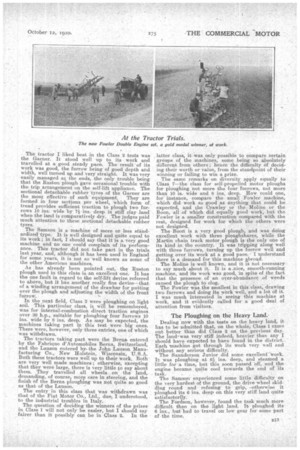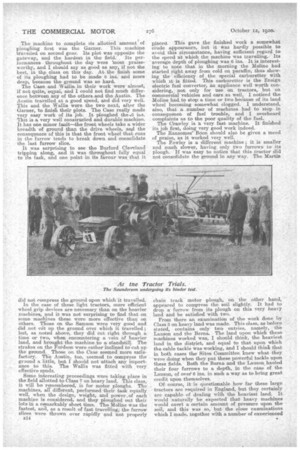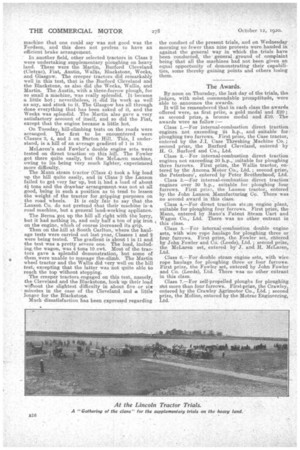THE LINCOLN TRACTOR TRIALS.
Page 32

Page 33

Page 34

Page 35

Page 36

If you've noticed an error in this article please click here to report it so we can fix it.
A Commentary Upon the Behaviour of the Agrimotors Competing for the Awards of the Royal Agricultural Society of England.--Contd.
By Our Agricultural Correspondent.
riHE TRACTOR TRIALS continued on to the end of the first week, the light land being ploughed an the first two days by all classes, with supplementary ploughing on similar land on the Wird day for all classes, of machines except Class 2 (direct traction engines, the horse-power of which did not exceed 30, and suitable for ploughing three furrows) and Class 5 (the internal-combustion double engine sets with wire rope haulage). These two classes, instead, were set to work ploughing heavy.land, and on the fourth day all the other clasSes were Set to the same task., I will, first of all, complete my comments upon the ploughing performances on the light land.
The first tractor met with upon. entering the field was the Wallis. It was pulling a two-furrow plough the same as the rest, on light land, and doing good work. It travelled very fast and appeared very eager to get as much-work done as possible.
The Austin did really first-class work. It had a good straight furrow, and its work progressed steadily but surely., and it 'could n o t fail to please both the judges and the public with its performance. Again the Burford Cleveland chain track machine did an excellent furrow, quite straight and well set up. This machine certainly deserves the credit of being well in the running for the best work, the only thing about it being that, for general work, farmers do not like the chain track machine. However; in regard to the Burford Cleveland, it has been found that this maChine is highly suitable for certain classes of work, particularly in hop yards and fruit planta
tions. The base was at work by the side of it, and the quality of its work was equal to that of the other tractors, being considerably better than its performance in Class 2.
The Fordson was travelling extremely fast, but. this did not seem to prevent its doing first-class work. Both the tractor and the plough were very well handled by the operator, The Ferdson showed what it is possible to do travelling at a fast rate. To be quite candid, it appeared to be rather too eager and in danger of. over-reaching itself and, in consequence of this, the engine was seen to be rather warm at times.
The tractor I liked best in the Class 2 tests was the Garner. It stood well up to its work and travelled at a good steady pace. The result of its work was good, the furrow being of good depth and width, well turned up and very straight. It was very easily managed at the ends, the only trouble being that the Ruston plough gave occasional trouble with the trip arrangement on the self-lift appliance. The sectional detachable rubber tyres of the Garner are the most effective of such equipment. They are brined in four sections Per wheel, which form of tread provides sufficient traction to plough two furrows 10 ins. wide 'by 7i-ins. deep in stiff clay land when the land is comparatively dry. The judges paid much attention to these sectional detachable rubber tyres.
The Samson is a machine of more or less standardized type. It is well designed and quite equal to its work; in fact, I should say that it is a. very good machine and no one could complain, of its performance. This tractor did not take part in the trials last year, and, although it has been used in England for some years, it is not so well known as some of the other American machines.
As has already been pointed out, the Ruston plough used in this claSs is an excellent one. It has the one fault in regard to the self-lift device referred to above, but it has another really fine device—that of a winding arrangement of the drawbar for putting over the plough and adjUsting the width of the front furrow.
In the next field, Class 3 were ploughing on light soil. This particular class, it will be remembered, was for internal-combustion direct traction engines over 30 h.p., suitable for ploughing four furrows 10 ins, wide by 8 ins. deep. As may be e-xpected, the machines taking part in this test were big ones. There were, however, only three entries, one of which was withdrawn.
The tractors taking part were the Berna entered by the Fabrique d'Automobiles Berna, Switzerland, and the Lauson entered by. the John Lauson Manufacturing Co., New Holstein, Wisconsin, U.S.A. Both these tractors were well up to their work. Both are very well made machines; otherwise, excepting that they were large, there is very little to say about them. They travelled all wheels on the land, demanding, of course, more care in steering, and the finish of the Berna ploughing was not quite so good as that of the Lauson.
The entry in this class that was withdrawn was that of the Fiat Motor Co., Ltd. due, understood, to the industrial troubles in itaiy. The question of deciding the winners of the prizes in Class 1 will not only be easier, but I should say fairer than it possibly can be in Class 2. In the latter class, it was only possible to compare certain groups of the machines sonic being so absolutely different from others; hence the difficulty of deciding their worth or value, from the standpoint of their winning or failing to win a prize. The same remarks on diversity apply equally to Class 7—the class for sell-propelled motor ploughs for ploughing not more the four 'furrows, not more than 10 is. wide and 8 ins. deep. How could one for instance, compare the small Fowler machine, which did work as good as anything that could be expected, and the Crawley or the Moline or the Boon, all of which did equally good work, but the Fowler is a smaller construction compared with the rest, designed for work for which the others were not designed. The Boon is a very good plough, and was doing excellent work with three ploughshares, while the Martin chain track motor plough is the only one of its kind in the country. It was tripping along well with three furrows, turning up the furrow well and getting over its work at a good pace.' I understand there is a demand for this machine abroad. The Moline is well known, and it is not necessary to say much about it. It is a mice, smooth-running machine, and its work was good, in spite of the fact that the presence of an over-abundance .of weeds caused the plough to clog. The Fowler was the smallest in this class; drawing two furrows and doing its Work well, and a lot of it. I was much 'interested in seeing this machine at work, and it evidently called for a good deal of attention from visitors.
The Ploughing on the Heavy Land.
Dealing now with the tests an the heavy land, it has to be admitted that, on the whole, Class 1 cattle out better than did Class 2 on the previous' day_ The land' was very stiff indeed, heavier than any I should have expected to have found in the district. Each machine got through its work very well and without any serious difficulty. The Saunderson Junior did some excellent work. It was ploughing at 61 ins, deep, and steamed a little for a time, but this soon passed off, and the engine became quite cool towards the end of its task. The Samson experienced some little difficulty on the very hardest of the ground, the drive wheel skidding round and refusing to grip, -otherwise it ploughed its 6 ins, deep on this very stiff land quite satisfactorily. The Fordson, however, found the task much more
difficult than on the light land. It ploughed its 6 ins., but -had to travel on low gear for some Part
of the time.
The machine to complete its allotted amount I of ploughing first was the Garner. This machine travelled on second gear. Its plot was oppostte the gateway, and the hardest in the field: Its perIormances throughout the day were 'most praiseworthy, and I should say as good as any, if not the best, in the class on this day. At the finish some of its ploughing had to be made 8 ilia. and more deep, because the ground was so hard. The Case and Wallis, in their work were almost, if not quite, equal, and I could not find much difference between any of the others,and the Austin. The Austin travelled at a good speed, and did very well. This and the Wallis were the two next, after the Garner, to finisfi their plots. The Case really made very easy -work of its job. It ploughed the .6 This is a very well constructed and durable machine. It has one minor fault—the front wheels take a wider breadth of ground than the drive wheels, anti the consequence of this is that the front wheel that runs in the furrow tends to break down and consolidate the last furrow slice.
It was surprising to see the Burford Clevtland tripping along, and it was throughout fully equal to its task, and one point in its favour was that it did not compress the ground upon which it travelled. In the case of these light tractors, more efficient wheel grip devices are, necessary ths.n on the heavier machines, and it was not surprising to find that on some machines these were more effective than on others. Those on the Samson were very good and did not mit up the ground over which it travelled ; but, as noted above, they did cut right through a time or two' when encountering a vein of heavier land, and brought the machine to a standstill. The strakee on the Ford son were rather inclined to cut up the ground. Those on the Case seemed more satisfactory. The Austin, too, seemed to aompress the ground a. little, but I should not attach any importance to this. The Wallis was fitted with very effective spuds.
Some interesting proceedings were taking place in the field allotted to Class 7 on heavy land. This class, it will be remembered, is for motor ploughs. The machines, all different, performed their task equally well, when the design, weight, and power_of each machine is considered, and they ploughed out their lots in a remarkably short time. The Moline was the fastest, and, as a result of fast travelling, the furrow slices were thrown over rapidly and not properly E14 placed. This gave the finished work a somewhat crude appearance, but it Was hardly possible to avoid this circumstance, having sufficient regard to the speed at which the machine was travelling. Its -average depth of ploughing was 6 ins. It is interesting to note that in the morning the Moline had started right away from cold on paraffin, thus showing the efficiency of the special carburetter with which it is fitted. This carburetter is the Ensign electric fuel converter, an appliance well worth considering, not only for use on tractors, but on commercial vehicles and ears as well. I noticed the Moline had, to stop a time or two beause of its land wheel becoming somewhat clogged. I understand, also, that a number of machines had to stop in • consequence of fuel trouble, and I overheard complaints as to the poor quality of the fuel. The Crawley is h very fast machine. It finished its job first, doing very good work indeed. The Ransotnee Boon should also be given a meed of praise, as it worked very well. The Fowler is a different machine; it is smaller and much slower, having only two furrows to its plough. It was easy to notice that this tractor did not consolidate the ground in any way. The Martin chain trackmotor plough, on the other hand, appeared to compress the soil slightly. It had to drop a furrow from its plough on this very heavy land and be satisfied with two.
From there an examination of the work done fly Class 3 on heavy land was made. This class, as before stated, contains only two entries, namely, the Lauson and the Berna. The land upon which these machines worked was, I should think, the heaviest land in the district, and equal to that upon which the cable tackle was working, and I should think that in both cases the Sites Committee knew what they were doing when they put these powerful tackle upon these fields. Both the Berna and the Lauson hauled their four furrows to a depth, in the ease of the Lauson, of °vet 6 ins, in such a way as to bring great credit upon themselves. Of course, it is questionable how far these large tractors are required in England, but they certainly are capable of dealing with the heaviest land. It would naturally be expected that heavy machines would exert a certain amount of pressure upon the soil, and this was so, but the close examinations which I made, together with a. number of exnerienced farmers, convinced me that the compression was not enough to injure the land. Of course, it was dry, but, in any case, such land would not be ploughed or cultivated in the wet.
The Lauson did the best work and was the faster of the two machines. The Berna had an unfortunate mishap which cauSed a. certain amount of delay. The ditch which separated the field from the hedge had not been brushed out and the oldgrass having grown to a level with the field, the driver did not notice that, a ditch existed, driving too near the edge, so that the Berna slipped in, and some difficulty was experienced in getting it out, but this was managed all right eventually.
Classes 4, 5, and 6 were further tested on heavy land, and though they had something to contend with in the way of heavy soil, the work was done admirably.
The belt test, I should think, was a very useful one, if severe. Some of •the machines came out of this test quite satisfactorily, while others practically failed, but it will not be possible to obtain any results until the -judges issue their reports.
At the end of the week, Class 7 (motor ploughs) were tested on the time taken to change from their plough to cultivator, and the machines were also tested on the actual operation of cultivating.
The Moline appears to be quite a. quick change machine ; using a Ransoine's cultivator, it was able to get through its work rapidly and without much. trouble. The land wheel of the Boon was rather inclined to slip. This agrimotor had a Ransome's cultivator also. The Martin chain track took rather a long time to change-14i minutes, but it did very well, and did not stick in the sodden soil. The Crawley was the only one to make any attempt at real cultivating, which it did thoroughly well with a Martin cultivator (old type). The Martin agrimotor used their self-liftcultivator.
It was interesting to note, in connection with these combined motor ploughs that ploughing contractors find a machine like the Crawley more profitable than any other for contract ploughing. The land, at the time the cultivating testa were carried out with Class 7, was not in a fit state for cultivating, and I really do not think that these tests ought to have been proceeded with. It is not a practice that could ordinarily be attempted on any farm. There had been very much rain in the night and the whole of this terribly heavy land was in a most dreadful state. Six tractors in Class 2 were selected for supplementary tests on Saturday. They were the Twin City, Case, Peterboro', British Wallis, Hart-Parr, and the Glasgow. To all appearances, the Wallis did the best, but of course it is difficult to say, because one could not obtain the fuel consumption results of all the machines, but, other things being equal, the Wallis would stand a good chance of being well to the fore in this class in these trials.
The Twin City used 3.1 gallons of paraffin for ploughing one acre. The temperature to start with was 160 degrees—as it was warm at the time—and, when finished, 165 degrees. The Hart-Parr used pint of petrol and 2 gallons 5 pints of paraffin for ploughing a good acre, and the temperature went up 15 between the start and the finish of the test.
I was not able to obtain any figures with regard to the Wallis, Peterboro', or the Case. One noted that the ma-chines in this class experienced no difficulty as a result of the rain which had fallen ; but in the case of Class 1, which started ploughing in the afternoon, very heavy rain falling immediately afterwards made things so very difficult that eventually the test had to be abandoned.
The Austin kept up right through, but the Fordson got completely stuck. The Case (the small machine) was also held, and the Wallis had difficulties. These were the only machines selected in this class. Although on Sunday the weather had been fine nearly all day, heavy rain set in again on Monday and lasted throughout the day, making the tests under these conditions very severe. " Belt pulley tests were continued at Seampton* Aerodrome, but it is not possible,to give any figures of the results as these were not available, neither is it possible to give these in regard to the drawbar tests, as the instrument did not record the results direct. They have to be worked out. Hill-climbing and brake tests were carried out on a hill field near Scampton Village, and the wheel tractors succeeded in climbing the' hill most satisfactorily; but the combined motor ploughs (Class 7) were not so good. In the latter class, of the three— the Crawley, the Boon, and the Moline—taking part • on Monday, the Crawley was, I should say, the best. The following were the tractors taking part : —The Hart-Parr, Wallis, Peterboro', the smaller and larger Case tractors, the Emerson, and the Fordson, and all did the job satisfactorily. On the brake tests going down the hill, the only machine that one could say was not good was the Fordson, and this does not profess to have an efficient brake arrangement.
In another field, other selected tractors in Class 2 were undertaking,supplementary ploughing on heavy land. These were the Martin, Burford Cleveland (Cletrac), Fiat, Austin, Wallis, Blackstone, Weeks, and Olasgow. The creeper tractors did remarkably well in this test, that is the Burford Cleveland and the Blackstone, as also did the Weeks, Wallis, and Martin. The Austin, with a three-furrow plough, for so small a machine, was really splendid. It became a. little hot ; nevertheless, it ,did its work as well as any, and stuck to it, The Glasgow has all through done everything that has been asked of it, and the Weeks was splendid. The Martin also gave a very satisfactory account of itself, and so did the Fiat, except that the engine became a little hot.
On Tuesday, hill-climbing tests on the roads were arranged. The first to be encountered were Classes 3, 4, and 6 on Burton Hill. This, I understand, is a hill of an average gradient of 1 in 10.
McLaren's and Fowler's double engine sets were tested on direct traction on this hill. The Fowler got there ,quite easily, but the McLaren machine, owing to its being very much lighter, experienced more difficulty. The Mann steam tractor (Class 4) took a big load up the hill quite easily, and in Class 3 the Lauson failed to get very far up, but it had a load of about 4itons and the drawbar arrangement was not at all good, being in such a position as to tend to lessen the weight of the tractor for .gripping purposes on the road wheels. It is only fair to say that the Lauson-Co. do not pretend that their machine isa road machine, but a general land-working appliance.
The Berna got up the hill all right with the lorry, but it had nothing in, and only half a ton of pig iron on the engine, which of course increased its grip.
Then on the hill at South Carlton, where the haulage tests were carried out last yeas, Classes 1 and 2 were being tested. The gradient is about 1 in 11 and the test was a pretty severe one. The load, including,-the wagon, was 4 tons 10 cwt. Most of the tractors gave a splendid demonstration, but some of them were unable to ma,naFe the ,climb. The Martin wheel tractor and the Wallis did very well on the hill test, excepting that the latter was not quite able to reach the top without stopping.
The creeper tractors engaged on this test, namely, the Cleveland and the Blackstone, took up their load without the slightest difficulty in about five or six minutes in the case of the Cleveland and a little longer for the Blackstone. Much dissatisfaction has been expressed regarding
the conduct of the present trials, and on Wednesday morning no fewer than nine protests were handed in against the general way in which the trials have been .conducted, the general 'ground of complaint being that all the machines had not been given aft equal opportunity of demonstrating their capabilities, some thereby gaining points and others losing them.
The Awards.
By,noon on Thursday, the last day of the trials, the judges, with most commendable ptomptitude, were able to announce the awards.
It will be remembered that in each class the awards offered were, as first. prize, a gold medal and £20; as second prize -a bronze medal and The awards ware •as follow :—
Class 1.—For internal-combustion direct traction engines. not exceeding 24 lap., and suitable for ploughing two furrows. First prize, the Case tractor, entered by the J.I. Case Threshing Machine Co. ; second prize, the Burford Cleveland, entered by H. G. Burford and Co. Ltd. Class 2.—For internal-combustion direct traction engines not exceeding 30 hp., suitable for ploughing three furrows. First prize, the Wallis tractor, entered by the Ancona. Motor Co., Ltd. ; second prize, the Petenboro', entered by Peter Brotherhood, Ltd.
Class 3.—For internal-combustion direct traction engines over 30 h.p., suitable for ploughing four furrows. First prize' the Lamson tractor, entered by % the John Lausoti Manufacturing Co. There was no second award in'this class.
Class 4.—For direct traction steam engine plant, suitable for ploughing four furrows. First prize, the Mann, entered by Mann's: Patent Steam Cart and Wagon Co., Ltd. There was no other entrant in this class.
Class 5.—For internal-eom.bustion double engine sets, with wire rope haulage for ploughing three or four furrows. First prize, the Fowler set, entered by John Fowler and Co. (Leeds), Ltd. ; second prize, the McLaren set, entered by J. and H. McLaren, Ltd.
Class 6.—For double steam engine sets, with wire rope haulage for ploughing three or four furrows. First prize, the Fowler set, entered by John Fowler and Co. (Leeds), Ltd. There was no other entrant in this class.
Class 7.—For self-propelled ploughs for ploughing nbt more than four furrows._ First prize, the Crawley, entered by the Crawley Agrimotor Co., Ltd. ; second prize, the Moline, entered by the Metrac Engineering, Ltd.




























































